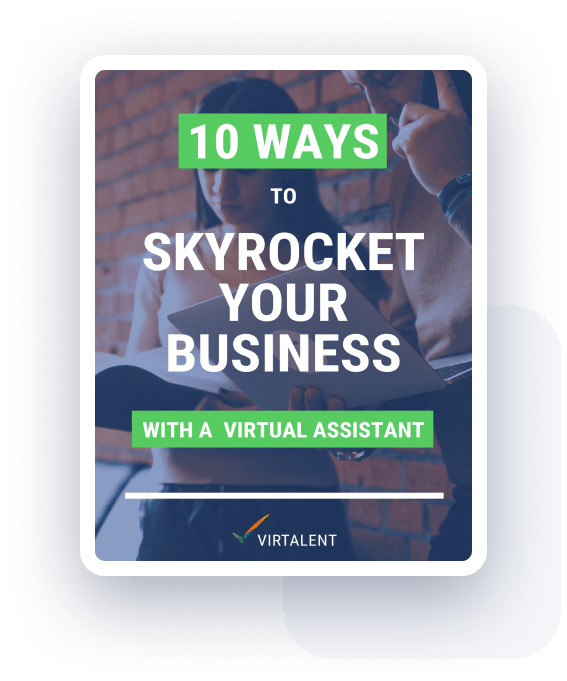Finding yourself a Virtual Assistant is the first step to building a far more productive, less stressful working day. Yet actually knowing how to use a Virtual Assistant properly – understanding the steps you need to get the most out of the relationship – can be an entirely different animal.
What practical guidance do you need in order to fully utilise the skills and experience of a VA, in the most effective way? How do you overcome hurdles, reservations and the dreaded prospect of inefficiency?
The Importance Of Good Delegation
Your Virtual Assistant is there to help – the clue is in the name. They are experts in assisting you during your working day. Yet they can only do that if they know what you want them do.
It is the clients that struggle to put what they want help with – and how they want it done – into words, that set themselves up for a bumpy journey. They haphazardly delegate whatever task happens to pop into their minds throughout the day. Yet it is the clients that take some time out to set themselves clear objectives, to think through exactly what they are asking their VA to do – ahead of asking them to do it, that set their new relationship up for success.
Delegating both efficiently and effectively is part art and part science. It can be difficult to get into the swing of it if you don’t give the process itself any thought at all.

Focus On The Long-Term Pay-Off
Rather than focusing on the time it will take for you to explain any single task to your VA, instead think about the net time you’ll have saved by not having to do that task yourself. It’s understandable to feel overwhelmed at first. But it’s important you commit to taking the time to explain the intricacies of your business, then to explain the key tasks you need help with in some detail… before your VA gets started.
The only way most clients feel motivated during this initial ‘onboarding’ process – as it can feel frustrating to have to set aside this time – is to focus on the end result they’ll enjoy for many months and years to come as a result. Think of the time you spend here as an investment.
If you have long-term, recurring tasks, such as inbox management or customer service tasks, the bonus is that you should only have to explain them once.
Explain these tasks in as much detail as possible. Provide screenshots or some other kind of supporting documentation if you feel this would be useful. Then, importantly, check that your Virtual Assistant had understood your instructions. It’s crucial they have an opportunity to ask questions before they start the work.
Choosing The Right Tasks To Delegate
This one can be difficult, partly because you feel like you don’t have the time to explain how to do the more intricate or difficult tasks on your plate and partly – as a result- because you feel like it’s just easier to do them yourself.
But it’s important to keep in mind why you started your business. It was to make heaps of cash and become a global titan in the industry, right? Or, at the very least, you wanted to do something more than what you were doing before, something better. You wanted to be a part of something special and to make choices that would ultimately lead to the continual growth and expansion of a thriving, successful business.
You didn’t envision your days being taken up with things that you realistically don’t have time to do (without completely sacrificing your personal life), don’t enjoy doing or don’t have any skills in doing. None of those situations are positive ones and eventually this conflict between the reality of a typical working day for you, and how you would really like to spend your time as a business owner, can be very demotivating.
The only way to change that reality is by delegating something in order to free up more of your time to work on other, ‘better’ stuff.
Now, the tasks that you want your VA to look after is entirely up to you. Make a list of all the things you need to do and decide which ones could be done by someone else. The ones you choose to delegate don’t need to be super simple, as long as you can make a little time to properly explain them to your VA.
The practical steps involved
I would recommend starting off by clearing any backlog you have of one-off, easily explained tasks. This could be cancelling a subscription, writing a complaint letter, buying something or researching a new mobile phone contract. Getting theses ticked off is going to start to clear your plate, help you see the benefits of working with a Virtual Assistant and you’ll begin to build a relationship with each other.
Whilst your Virtual Assistant is working on those tasks, set aside time to focus on what longer-term, recurring tasks they can look after for you. This could be anything from managing your diary and inbox, to taking care of your recruitment pipeline or incoming sales enquiries.
These tasks are evidently going to take some time to explain, so start by writing up some notes on each process, (Google Docs is perfect for this), and add screenshots where necessary (take a look at CloudApp). Try to anticipate any questions your VA would naturally have and ensure you give them access to any software they’ll need to use.
Next, set up a call with your VA to go through these and ‘hand over’ these crucial, long-term tasks. These are the tasks that will start to save you time. Every. Single. Day.

Use Their Expert Skills To Your Advantage
There is an incredibly long list of things that a Virtual Assistant could potentially help you with, but when you’re deciding how to use a Virtual Assistant most effectively, it’s important to take both their personal (or ‘soft’) and professional (or ‘hard’) skills into consideration.
You’ll most likely discover that your VA can help you with far more than you had originally thought. Some VAs have unique skills and experience in marketing, HR, project management, financial admin or entirely different areas, all of which you’d be forgiven for thinking you needed a separate specialist for.
Then there are the soft skills: time management, organisation, analytics skills, being particularly savvy at finding the best deals for you… these are all individual qualities that can make your new VA particularly useful in certain areas of your business.
The trick is not to pigeonhole your beliefs. Try not to think in terms of what they’re ‘supposed’ to do and instead think about what they can do for you.
Find The Right Fit
If you have any specific tasks in mind that you want a VA to complete for you, you need to ensure you find the right VA for your needs. ‘Virtual Assistants’ as a category of professionals that can do a whole lot, but some have skills that others don’t, and some require more flexibility whereas others can work more rigid working hours. Each professional is unique.
How many hours do you need them to work? What tasks do you need them to complete? What skills and industry experience do they need? Also think through the general feel of your business model and brand image. Is there something unique to your company that you need to factor into your search for your ideal Virtual Assistant?
At Virtalent, all of this is factored into our unique matching process!
It’s also crucial to make sure you talk to any potential VA – even if that’s just for a few minutes. You need to make sure you ‘click’ and they can meet your expectations, as well as give both of you an opportunity to ask each other questions.
Set Clear Expectations
Speaking of expectations, actually thinking about them and then setting them out clearly is imperative here. Simply giving someone a very vague description of who you want to work with or – when you have that person on board – what you want them to do, just isn’t going to cut it.
You need to be as clear and concise as you possibly can. Set out any “rules” and explain any key processes that need to be followed, in order to ensure you really do get what you expect from them.
Alongside the practical details around the tasks, such as any set processes or documents to follow, you should also let your Virtual Assistant know what your wider expectations are for the business as a whole.
An explanation of your long-term goals and how your new VA can work to help you achieve those goals, gives them access to the ‘bigger picture’. This then allows them to work towards the same long-term goal that you are, ensuring that everything they do adheres to the business’ basic principles, and also works towards pushing the company (and you, personally) forward in the direction you want. In addition, it is far more motivating for your new VA to feel that they are contributing in such a meaningful way!

How To Use A Virtual Assistant: Defining A Role
Ensuring that your new Virtual Assistant knows exactly what you want them to do, how you want them to do it and when you want them to do it, are all key.
At the heart of this discussion, ultimately, this is another way to say that your VA’s role should be clearly defined. Just like any other role in your business – whether that’s for an external supplier such as an accountant or a new staff member in Customer Services – there should be a clear breakdown of each responsibility that person has to take care of, as well as a concise breakdown of what your expectations are in each of these areas (goals or targets are always useful here).
Virtual Assistants are no different. Explain the kinds of tasks you need them to complete – what you need them do on a typical day, week or month – as well as any information around working hours or turnaround times. Make sure you clearly lay out any specifics on each area of the business your VA is taking care of.
Without a clearly defined job role, your Virtual Assistant might not know where they fit into the company, what they’re supposed to be doing or when they’re supposed to be doing it for you.
Manage, But Trust Your VA
Managing remote staff can feel different to managing in-house employees, so you may need to change your management style to suit the new working relationship.
Once you have defined a clear role for them, one of the most important factors in building a great partnership with your VA is trust. It’s important to ‘let go’ a little, even if it makes you feel uncomfortable at first.
If you don’t trust them to do what they’re supposed to be doing for you, trust they’ll do the work when they’re supposed to do it or trust in their approach to how they’re supposed to do it, then they won’t have the space to thrive. They can’t show you what they’re really made of, if you don’t let them.
Micromanagement takes up valuable time. This is time that could be spent doing something far more productive and rewarding. Once you’ve set the role and effectively delegated tasks to your new VA, they will be able to take it from there.
They know what they’re doing. There’s no reason to check up on them every five minutes or ask for continual updates. Make it clear when you need to be kept informed – upon the completion of a key milestone, for example – and then trust in them and in the process.
Give constructive criticism, check their work when this is valuable to both of you (at least at first) and have weekly or bi-weekly video or voice call meetings, so you can catch up on important things and delegate new tasks.
Encourage Input
This is similar to the aspect of trust, and it applies to almost every team member in any kind of work space, anywhere. Valuing your new colleague’s opinion on the things that they are experts in not only shows that you trust them, but it could add real value to your business.
They will inevitably have some great ideas, even if this is just because they have a fresh perspective, not having worked in your business for as long as you have. Remember that the tasks you have asked them to do fall into a remit that they are experts in; they’re professionals. They might have ideas on how to improve efficiency, get better results from marketing campaigns or make more impact.
Fostering a working environment where they feel valued will also make your VA more likely to go ‘above and beyond’ for you and your business.
Once you have a clear idea on their role, have made a start on delegating work (with a focus on recurring, long-term tasks), and continue to trust, believe in and encourage them, you’ll see the payoff. Learning how to use a Virtual Assistant effectively is a journey, but it is well worth the effort!
Looking to get started with a Virtual Assistant? Book a free consultation today!










Recent Comments